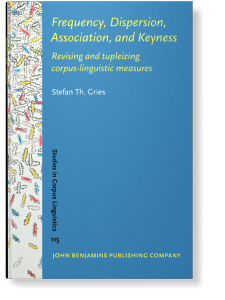Frequency, Dispersion, Association, and Keyness
Revising and tupleizing corpus-linguistic measures
This book is an attempt to revisit the main specifically corpus-linguistic statistics/measures the field has been relying on for decades: frequency, dispersion, association, and keyness. The book first discusses the purpose of these measures and how they have been measured. Then, the book makes three main proposals: First, that many measures of dispersion, association, and keyness are too confounded with frequency and how to 'take frequency out of them' to obtain conceptually cleaner and more interpretable measures. Second, that many existing measures can be replaced by the simple information-theoretic measure of the Kullback-Leibler divergence and that it, too, can have frequency 'removed' from it. Third, that corpus linguistics should abandon the tradition of trying to describe its findings with a single number and adopt a tupleization approach instead, where we use several separate dimensions of information for description and interpretation. The book is written in an informal, hands-on style and comes with its own R package featuring functions, example data, and several thousand lines of code exemplifying all applications.
[Studies in Corpus Linguistics, 115] 2024. vii, 321 pp.
Publishing status: Available
© John Benjamins
Table of Contents
-
Chapter 1. Introduction | pp. 1–11
-
Chapter 2. A review: Corpus statistics, the ‘usual’ approaches | pp. 12–79
-
Chapter 3. Unification of measures | pp. 80–169
-
Chapter 4. The role, and the ‘partialing out’, of frequency | pp. 170–228
-
Chapter 5. Tupleization | pp. 229–268
-
Chapter 6. What should be next | pp. 269–303
-
Chapter 7. Conclusion | pp. 304–307
-
References | pp. 308–318
-
Index | pp. 319–321
Subjects
Main BIC Subject
CFX: Computational linguistics
Main BISAC Subject
LAN009000: LANGUAGE ARTS & DISCIPLINES / Linguistics / General
